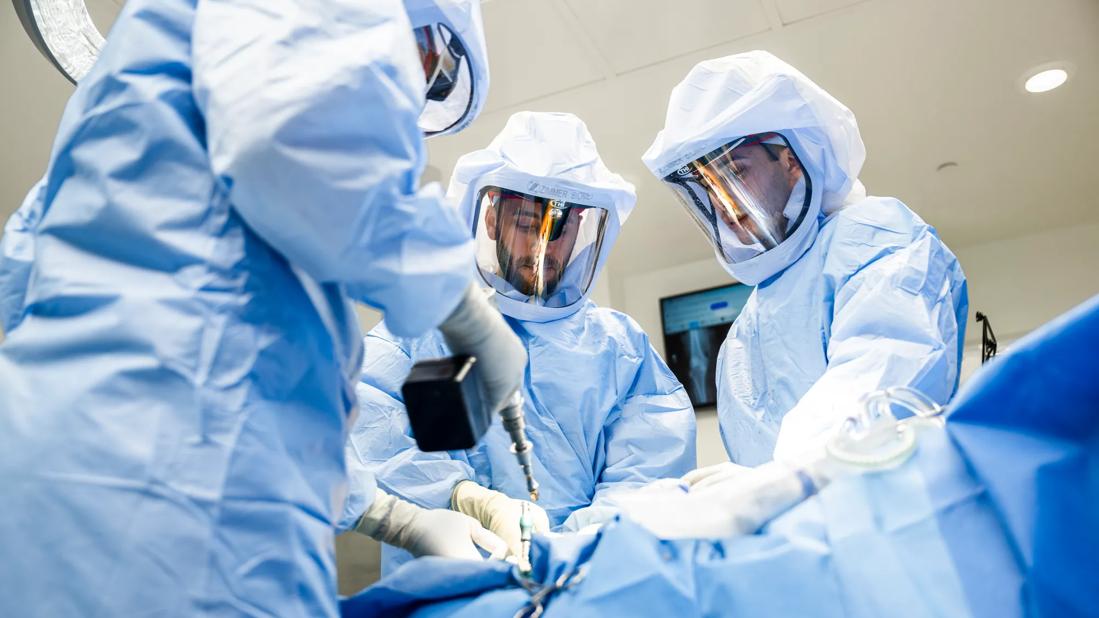
The goal of robot-assisted technology in total hip arthroplasty (THA), first introduced in the 1990s, is to reduce prosthetic malpositioning and improve patient outcomes. While the use of robotics in primary THA has made brisk inroads in the last decade, its application in hip revision surgery is much rarer, according to Jorge Manrique-Succar, MD, a dual specialist in musculoskeletal oncology and joint replacement surgery based at Cleveland Clinic Weston Hospital.
Advertisement
Cleveland Clinic is a non-profit academic medical center. Advertising on our site helps support our mission. We do not endorse non-Cleveland Clinic products or services. Policy
As Sarcoma Program Director for Cleveland Clinic in Florida, Dr. Manrique has successfully applied robotic technology and 3D navigation to care for patients with pelvic tumors and severe acetabular defects for the past three years and more recently expanded its application to revision hip surgery.
In 2021, Dr. Manrique reported on a unique orthopaedic oncology case in the JBJS Case Connector involving a 76-year-old man who presented with metastatic renal cell carcinoma (RCC) in the right acetabulum with pelvic compromise. Imaging studies revealed a metastatic osteolytic lesion that had destroyed the posterior acetabular column and eroded into the hip joint.
Due to the patient’s hip pain, inability to ambulate independently, and difficulty performing activities of daily living, surgical intervention was recommended. Dr. Manrique performed a tumor resection and used a robot-assisted approach for anatomic pelvic reconstruction and prosthetic component placement.
According to the case report, surgical planning and reconstruction was performed using the Mako Robotic-Arm Interactive Orthopaedic (RIO®) System. The surgical plan included tumor embolization and resection, insertion of navigation-assisted pelvic Steinmann pins and screws into the defect as rebar for cement placement, attachment of two bridging plates to the posterior column and wall, and joint reconstruction using robot-assisted total hip arthroplasty.
“In this case, we customized the Makoplasty stereotactic probe to accommodate both a drill bit and a Steinmann pin,” describes Dr. Manrique. “The probe was then used to visualize and achieve the desired trajectory during placement.”
Advertisement
Dr. Manrique notes the hip was reduced with good stability and no leg length discrepancy. At one-year follow-up, no migration or loosening was observed and no recurrent neoplasm was present. The patient also ambulated without assistive devices and was reported to be satisfied with his results (Harris Hip Score of 88.8).
Since that case, Dr. Manrique has successfully used the robotic arm-assisted technology to optimize implant positioning and improve reconstruction quality in terms of fixation and stability for a number of patients with orthopaedic cancers.
Earlier this year, Dr. Manrique applied the approach to perform Cleveland Clinic Weston Hospital’s first robot‐assisted hip revision procedure for a 72-year-old patient who suffered from recurrent right-side hip dislocation.
“Acetabular bone defects are a key concern of hip revision surgery,” says Dr. Manrique. “Our goal was to restore the patient’s hip joint stability and rotation and the integrity of the acetabulum while maximizing bone preservation. It was a very challenging surgery.”
A CT scan was used to generate a 3D model of the patient’s pelvic and femoral anatomy, which was then used to create a preoperative plan. “In revision surgery this is complicated by existing implants and altered bony landmarks,” notes Dr. Manrique.
Following removal of the original implants, Dr. Manrique and his surgical team used the robot‐assisted technology to perform acetabular reaming and cup placement, aided by 3D real‐time navigation. Intra-operative adjustments were made within haptic boundaries established by the robotic system.
Advertisement
“The technology allowed us to achieve the precise angle determined in preoperative planning and within both Lewinnek’s and Callanan’s safe zones,” he says. “Computer navigation assistance also supported the manual implantation of the femoral stem and head and was used to assess leg length.”
Postoperative measurements confirmed the procedure adhered to the preoperative plan. “We achieved good radiological and clinical results with this approach,” says Dr. Manrique.
In an analysis of 4,699,894 patients from the National Inpatient Sample (NIS) database who underwent primary THA between 2008 and 2018, a team of Cleveland Clinic researchers observed an 18-fold increase in robotic arm-assisted total hip arthroplasty (RA-THA) from < 0.1% in 2009 to 2011 to 2.3% in 2018. Their projections, based on historical trends, show an expected exponential rise in the annual use of RA-THA, reaching 23.9% of all THAs in 2025 and accounting for two-thirds of procedures by 2030.
“My colleagues predict this is the decade that robot-assisted surgery will overtake manual surgery for patients requiring joint replacement surgery,” says Dr. Manrique. “While the benefits in terms of surgical planning and improved implant placement in primary cases are well documented, I believe patients with orthopaedic tumors and severe acetabular defects and those requiring revision hip surgery have more to benefit from a robotic approach.”
Advertisement
Advertisement

Noninvasive modality gains ground in United States for patients with early-to-moderate disease

Cleveland Clinic Weston Hospital’s collaborative model elevates care for complex lung diseases

Interventional pulmonologists at Cleveland Clinic Indian River Hospital use robotic technology to reach small peripheral lung nodules

Trained in the use of multiple focal therapies for prostate cancer, Dr. Jamil Syed recommends HIFU for certain patients with intermediate-risk prostate cancer, especially individuals with small, well-defined tumors localized to the lateral and posterior regions of the gland.

Cleveland Clinic Weston Hospital is actively recruiting patients for an international, multicenter, phase III study comparing MIS versus open interval cytoreduction following neoadjuvant chemotherapy in patients with stage IIIC-IV epithelial ovarian cancer.

Urologic oncologist with Cleveland Clinic in Florida performs robotic-assisted retroperitoneal lymph node dissection.

Cleveland Clinic researchers in Florida identify unexpected survival benefit

Noninvasive, radiation-free imaging supports treat-to-target IBD care